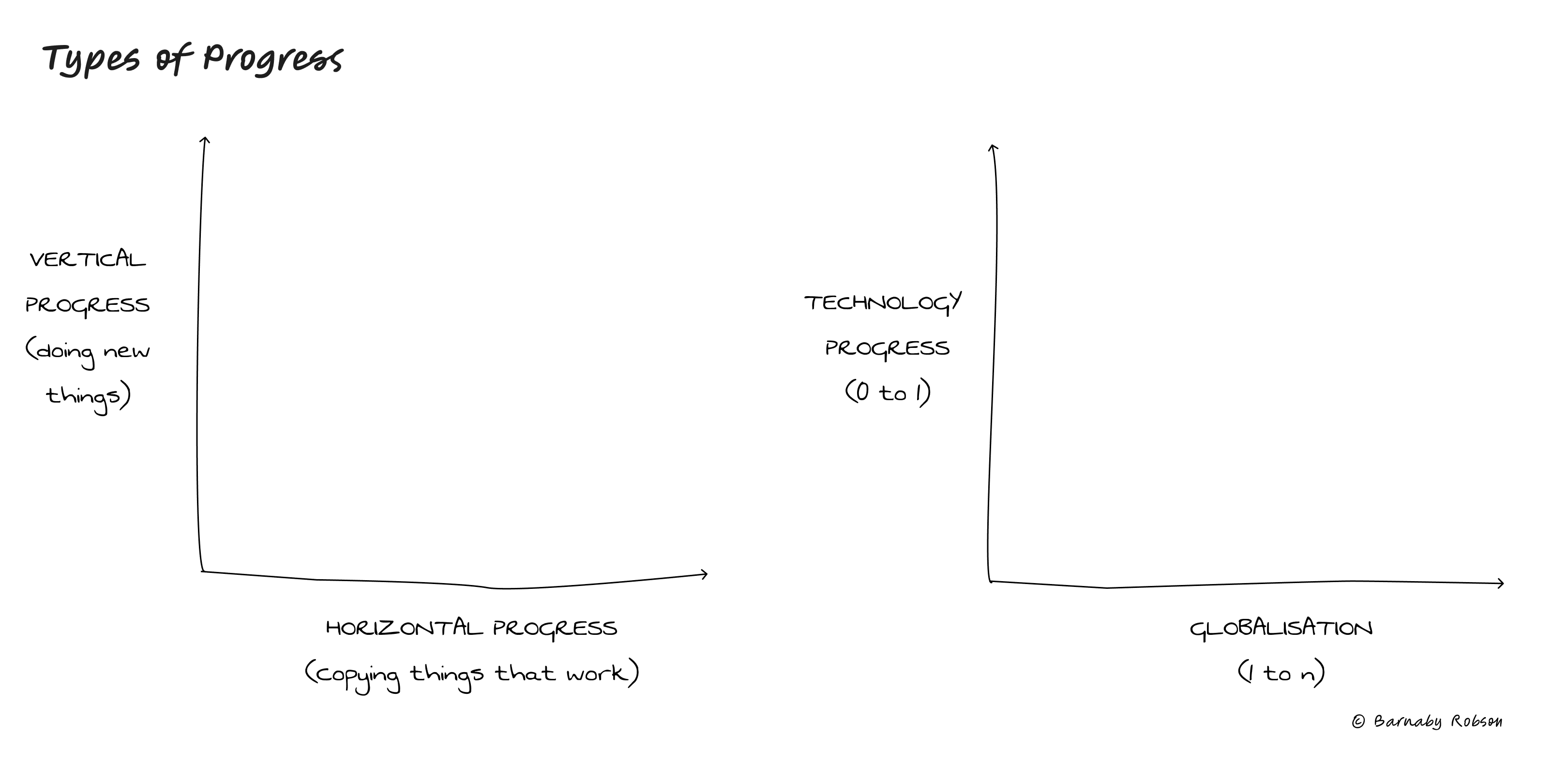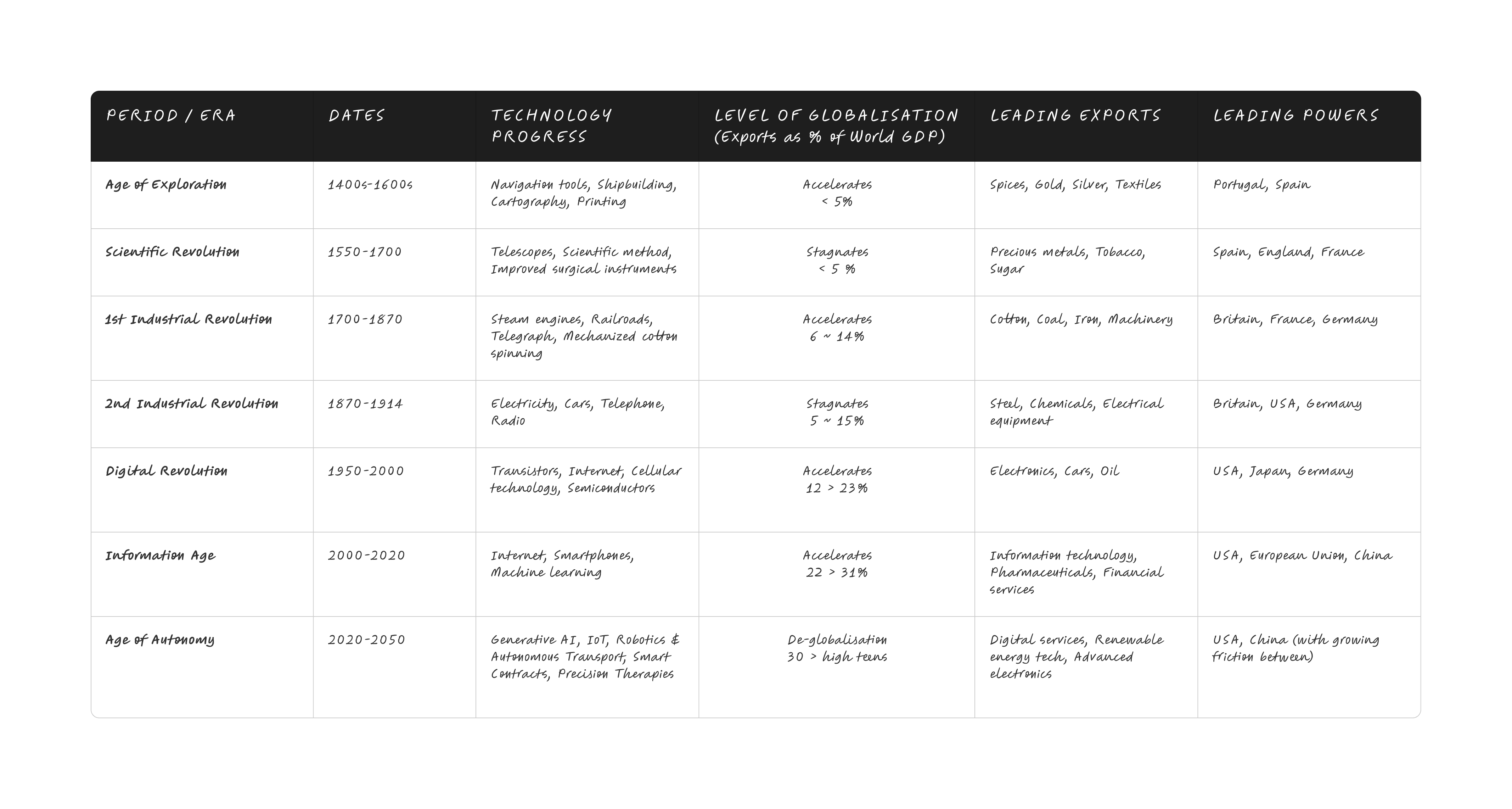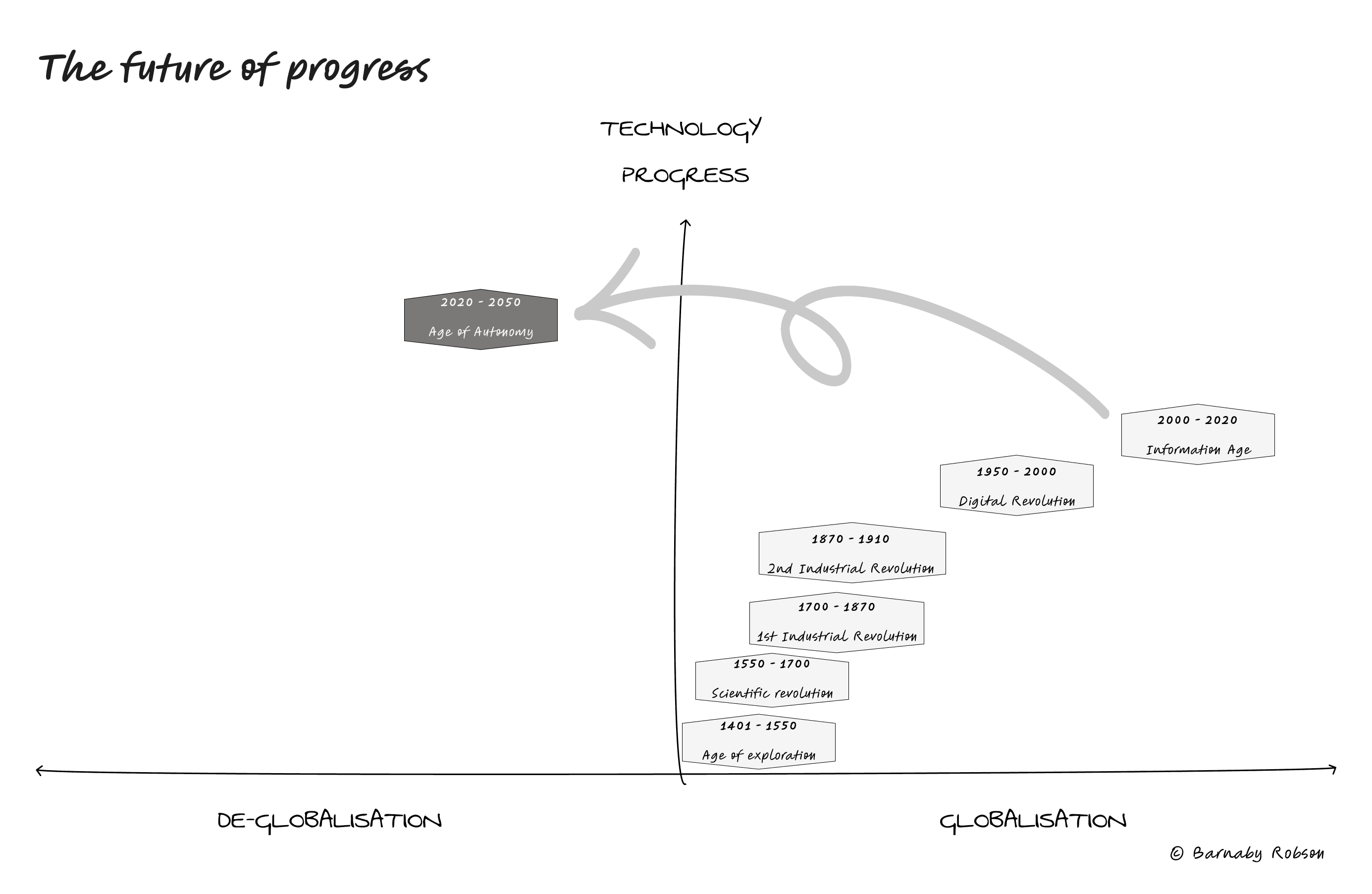The two biggest drivers of wealth and value creation in our lifetimes have been technology and globalisation. One of these is accelerating and the other is reversing.
Anyone investing in or running businesses – especially global businesses – needs to form a view of what this means. This is my attempt.
The history of progress
In the book Zero to One Peter Thiel explains the concepts of Vertical and Horizontal progress:
- Horizontal Progress is about copying things that work. Imagine you have a typewriter and you produce 100 more of them. You’ve made horizontal progress. It’s about scaling and replication. In the context of the global economy, this is akin to globalisation. It’s about taking things that work in one place and spreading them everywhere. It’s the China approach of the 20th century: taking what’s been done and doing it more.
- Vertical Progress, on the other hand, is doing new things. It’s going from 0 to 1. Instead of another typewriter, you invent a word processor. This is innovation and breaking the mold, which is basically what we call Technology.

Source: Zero to One by Peter Thiel. Graphic by me.
Zooming out this table sets out how different globalisation and technology eras align:

Source: World Bank Data re level of globalisation. Table by me.
Globalisation and its discontents
Now, let’s talk about the current state of the world. We’re seeing signs of deglobalisation – countries turning inwards, questioning the benefits of a globalized economy. Trade barriers are going up, and there’s a growing skepticism about global institutions.
Yet, in this backdrop, certain technologies, especially AI, are accelerating at an unprecedented rate. It’s a fascinating juxtaposition. On one hand, the physical world seems to be decelerating, becoming more insular. But in the digital realm, borders are disappearing, and innovation is skyrocketing.
So, here’s the question I’m pondering: What does it mean for our future when, on one hand, we’re entering a period of deglobalisation (i.e. Horizontal Regression), while on the other, technologies like AI are advancing at breakneck speeds (Vertical Progress)? How will these opposing forces shape the next chapter of our global story?

The Age of Autonomy
We’re on the brink of a paradoxical era. Progress now has two faces: one that looks to the future and another that harks back to the past.
Technological Renaissance:
Generative Artificial Intelligence isn’t mere incremental progress; it’s a foundational shift because it goes beyond enhancing existing capabilities—it opens new realms of possibility. It can generate creative, original outputs, drastically extending the range of tasks machines can perform. This foundational shift allows for more sophisticated interactions and applications, moving closer to human-like creativity and problem-solving.
Blockchain, while often relegated to discussions about cryptocurrencies, holds the promise of true autonomy. As trust in monolithic institutions erodes, blockchain offers a decentralized paradigm, a counter-narrative to centralized control. It’s a step towards a future where systems operate on consensus rather than authority.
Elon Musk, a figure often associated with audacious ventures, embodies this spirit of the age. His endeavors, from Tesla’s electrification drive to SpaceX’s spacefaring ambitions, are not just businesses; they’re statements about the future. His early backing of OpenAI underscores the transformative potential of AI. And while he may not be crafting blockchain solutions, his advocacy underscores its disruptive potential.
Beyond the economic and technological implications, these advancements in AI and blockchain might redefine our societal norms. From how we work, communicate, to even how we perceive trust and authenticity, the ripple effects could be profound.
Global Fragmentation:
The geopolitical tapestry is undergoing a profound transformation. The age of unfettered globalization, a hallmark of the late 20th century, is yielding to an era of regionalism and strategic realignments. This isn’t a mere retreat; it’s a recalibration. Digital barriers emerge, economic moats deepen, and local traditions resurge. The challenge lies not in resisting this tide but in navigating it.
The U.S.-China dynamic increasingly mirrors the Thucydides Trap, a historical pattern where a rising power threatens an established one. This isn’t a transient phase; it’s a structural shift. As the U.S. inches towards isolationism, underpinned by self-sufficiency in semiconductors and energy, sectors like robotics and new energy stand to benefit.
China’s trajectory, with echoes of Japan’s post-Plaza Accord phase, is marked by demographic and economic challenges. Yet, its capital flows towards ASEAN, the Middle East, Africa, and Latin America, hint at a strategic pivot. The BRICS narrative too is evolving. While India seeks a middle path, other members, alongside much of Africa, seem to gravitate towards China.
The BEPS 2.0 framework, slated for 2023 implementation, marks a pivotal change in global taxation for multinational corporations. Designed to address tax challenges in the digital economy, it aims to ensure MNCs are taxed where they generate revenues and enforces a minimum 15% tax on profits in each jurisdiction. This could reshape MNC strategies, potentially increasing their tax burdens and prompting a reevaluation of operations in certain markets due to economic viability concerns.
In this evolving landscape, one wonders: Could the future see a resurgence of city-states or neutral nations as pivotal players in the global landscape? These entities, unburdened by the weight of superpower politics, might emerge as agile, adaptive, and influential actors.
Economic Paradox:
The interplay between rapid technological advancement and geopolitical fragmentation creates a complex economic puzzle. While innovations like AI signal a future of exponential growth, the pullback from globalization introduces headwinds. Rising costs, sustained inflation, and the ensuing shift to tighter monetary policies may curtail investment, adding layers to this intricate landscape.
For those steering capital, the challenge is twofold: understanding these macro shifts and identifying the micro opportunities they birth. Here’s where I think discerning capital allocators might focus:
- Technology: The technological renaissance is undeniable, and with it comes a plethora of investment opportunities. Companies at the forefront of AI, blockchain, and sustainable energy solutions are poised for significant growth. The key is to identify those that have a clear path to scalability and a sustainable competitive advantage.
- Capital Flows & Neutral Grounds: As the geopolitical landscape becomes increasingly polarized between the US and China blocks, there emerges a unique opportunity for neutral states. These countries, strategically positioned between the two giants, could play a pivotal role in the global order. By not aligning definitively with either block, they can serve as mediators, facilitators, and even as economic hubs, drawing investment and capital from both sides. It’s not just Chinese capital that’s on the move. Middle Eastern sovereign wealth, driven by a need to diversify away from oil, and US capital, seeking nearshoring opportunities in places like Mexico, are actively seeking new avenues. These neutral states, with their strategic positioning and non-aligned stance, are becoming increasingly attractive destinations. They offer a blend of risk and reward, with the added advantage of geopolitical neutrality. In this evolving scenario, the neutral states could emerge as the new epicenters of global capital flows, trade, and diplomacy. Their role might be reminiscent of the non-aligned movement during the Cold War, but with a distinctly economic flavor this time.
- Localized Solutions: With the trend towards self-sufficiency and localization, companies that offer localized solutions – be it in manufacturing, agriculture, or energy – are likely to thrive. This includes firms enabling robotics for localized manufacturing or those pioneering new agricultural technologies for regional food security.
- New Energy Paradigm: The shift away from fossil fuels not only represents an environmental imperative but also a geopolitical one. As nations become less reliant on oil, the traditional power dynamics, heavily influenced by oil politics, might see a recalibration. The term “sustainable” or “ESG” often evokes a sense of tokenism, a nod to concerns without substantive action. But the energy landscape is undergoing a genuine transformation. Nuclear power, especially with recent innovations in fission, is emerging as a reliable and clean energy source. The promise of superconductors, with their potential to revolutionize energy transmission, offers a glimpse into an efficient energy future. Solar power, battery technology, and other renewables are not just alternatives; they’re becoming the mainstay. As these technologies mature and scale, they’ll shape an energy paradigm that’s both sustainable and economically viable.

As we navigate the 21st century, the interplay between technological promise and geopolitical realities will shape our world in ways we can’t fully predict. The challenge lies not just in harnessing the power of innovation but in doing so in a world that’s increasingly fragmented. How we adapt to this challenge will drive individual and business success in the coming decades.
References and borrowed ideas
This Essay was inspired by the book Zero to One by Peter Thiel. I highly recommend readers explore the book which, though published in 2014, is in many ways more relevant today than ever.
Data on exports of goods and services as a percentage of Global GDP (best proxy for tracking levels of globalisation) is available from the World Bank Here: https://data.worldbank.org/indicator/NE.EXP.GNFS.ZS. The data shows for China, the US and India, the peak was c. 2006 – 2010
Disclaimer:
Note: The following are personal views based on current trends and observations. They are not to be construed as financial advice.
